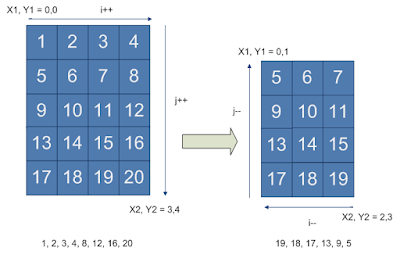
Solution: There are several ways to solve this problem, but I am mentioning a method that is intuitive to understand and easy to implement. The idea is to consider the matrix similar to onion which can be peeled layer after layer. We can use the same approach to print the outer layer of the matrix and keep doing it recursively on a smaller matrix (with 1 less row and 1 less column).
Refer to the image below for a visual explanation. We start by printing the top-right layer of the matrix by calling the print_layer_top_right. It will print 1,2,3,4,8,12,16,20. The print_layer_top_right method then calls the print_layer_bottom_left method which will print 19,18,17,13,9,5. If you observe the size of the target matrix is reducing after each call. Each method basically calls the other method and passes the matrix indexes for the reduced matrix. Both methods take 4 index parameters which represent the target matrix. When the target matrix size is such that there is only one layer left the recursion terminates and by this time the code has printed all the numbers in the full matrix.

Code (C language):
#include <stdio.h>
void print_layer_top_right(int a[][4], int x1, int y1, int x2, int y2);
void print_layer_bottom_left(int a[][4], int x1, int y1, int x2, int y2);
int main(void)
{
int a[5][4] = {
{1,2,3,4},
{5,6,7,8},
{9,10,11,12},
{13,14,15,16},
{17,18,19,20}
};
print_layer_top_right(a,0,0,3,4);
}
//
// prints the top and right shells of the matrix
//
void print_layer_top_right(int a[][4], int x1, int y1, int x2, int y2)
{
int i = 0, j = 0;
// print the row
for(i = x1; i<=x2; i++)
{
printf("%d,", a[y1][i]);
}
//print the column
for(j = y1 + 1; j <= y2; j++)
{
printf("%d,", a[j][x2]);
}
// see if we have more cells left
if(x2-x1 > 0)
{
// 'recursively' call the function to print the bottom-left layer
print_layer_bottom_left(a, x1, y1 + 1, x2-1, y2);
}
}
//
// prints the bottom and left shells of the matrix
//
void print_layer_bottom_left(int a[][4], int x1, int y1, int x2, int y2)
{
int i = 0, j = 0;
//print the row of the matrix in reverse
for(i = x2; i>=x1; i--)
{
printf("%d,", a[y2][i]);
}
// print the last column of the matrix in reverse
for(j = y2 - 1; j >= y1; j--)
{
printf("%d,", a[j][x1]);
}
if(x2-x1 > 0)
{
// 'recursively' call the function to print the top-right layer
print_layer_top_right(a, x1+1, y1, x2, y2-1);
}
}
plz tell me why u have used this 4
ReplyDelete(int a[][4], int x1, int y1, int x2, int y2);
(int a[][4], int x1, int y1, int x2, int y2);
(int a[][4], int x1, int y1, int x2, int y2);
ReplyDelete(int a[][4], int x1, int y1, int x2, int y2);
why u've used 4 in both of these functions
could u plz tell me the flow of the program
ReplyDeleteand what is this?? "if(x2-x1 %gt; 0)"
if(x2-x1 %gt; 0)
{
// 'recursively' call the function to print the bottom-left layer
print_layer_bottom_left(a, x1, y1 + 1, x2-1, y2);
}
if(x2-x1 > 0)
{
// 'recursively' call the function to print the top-right layer
print_layer_top_right(a, x1+1, y1, x2, y2-1);
}
%gt; was typo while trying write the html encoding for > sign. It should be 'if(x2-x1 > 0)'. I have made the correction to the code above.
ReplyDeleteThanks for catching it.
You should change
ReplyDeleteif(x2-x1 > 0)
to
if(x2-x1 > 0 && y2-y1 > 0)
so you can support Matrix with more columns than rows.
nice!
ReplyDeleteThis comment has been removed by the author.
ReplyDeleteThis comment has been removed by the author.
ReplyDeletecan any one tell the solution to above problem with out using arrays
ReplyDeleteawesome concept bro and u have xplained it very wel
ReplyDeletethanks
rahul...
CODE (JAVA)
ReplyDeleteHOW ABOUT THIS LOGIC???
import java.io.*;
class spiralmatrix
{
static int a[][];
public static void main(String arg[])throws IOException
{
BufferedReader br= new BufferedReader(new InputStreamReader(System.in));
System.out.println("enter size of matrix");
int n=Integer.parseInt(br.readLine());
a=new int[n][n];
int p=1;
for(int i=0;i=min;j--)
System.out.print(a[i][j]+"\t");
for(i=i-1,j=j+1;i>=min+1;i--)
System.out.print(a[i][j]+"\t");
if(n==0)
System.exit(0);
else
abc(i+1,j+1,n-1,min+1);
}
}
what is min????
Delete#include
ReplyDelete#include
main()
{
int i,j,b,n,c,d,l,s,f;
n=5;
int a[n][n];
printf("\n Matrix is");
for(i=0;i0)
{
i=n-b;
for(j=(n-b);j<(n-f);j++)
{
printf("%d\t",a[i][j]);
}
l=l-1;
if(l>0)
j=n-d;
for(i=d;i<(n-f);i++)
{
printf("%d\t",a[i][j]);
}
l=l-1;
if(l>0)
i=n-d;
for(j=(n-s);j>=(n-b);j--)
{
printf("%d\t",a[i][j]);
}
l=l-1;
if(l>0)
j=n-b;
for(i=n-s;i>n-b;i--)
{
printf("%d\t",a[i][j]);
}
l=l-1;
d=d+1;
c=c-1;
s=s+1;
b=b-1;
f=f+1;
}
getch();
}
//Himanshu Negi @ himanshunegi1987@gmail.com
ReplyDelete#include
#include
void func(int a[][4],int,int,int,int);
void main(void)
{
clrscr();
int a[5][4] = {
{1,2,3,4},
{5,6,7,8},
{9,10,11,12},
{13,14,15,16},
{17,18,19,20}
};
func(a,0,0,4,3);
getch();
}
void func( int a[][4],int x,int y,int x1,int y1)
{
for(int i=x,j=y;j<=y1;j++)
{
cout<<" "<=y;j--)
{
cout<<" "<x;i--)
{
cout<<" "<0)
func(a,x,y,x1,y1);
}
Following site has a complete java code.
ReplyDeleteThis solution works as follows
1. print from top left to right top
2. print from right top to right bottom
3. print from right bottom to left bottom
4. print from left bottom to left top
then call the recursive function for inner layer continue till layer=min(rows,cols)/2
http://www.dsalgo.com/2013/02/PrintMatrixSpiral.php.html
#include
ReplyDelete#include
int main()
{
int m,n,i,j;
int **a;
scanf("%d%d",&m,&n);
a=(int**)malloc(sizeof(int*)*n);
for(i=0;i=0;j--)
{
printf("%d ",a[i][j]);
}
printf("\n");
}
return 0;
}